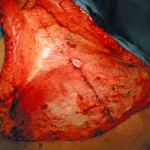
The muscles that a tummy tuck usually tightens are the rectus muscles. They are a large paired vertical muscles that run down the midline from the ribcage to the pubic bone. They are quite wide, often 4 to 6″ inches in diameter that provide a strong band of vertical support to the abdominal area. These muscles, like all muscles, are enveloped in a sheath of tissue known as fascia.
In women due to pregnancy and childbirth, these paired muscles that are normally joined in the midline can become separated. Technically this is known as rectus diastasis or split rectus muscles. This is not to be confused with a hernia, which is not just a separation, but an actual hole between the muscles where the bowel is poking through.A hernia is most likely to occur at the belly button or umbilicus since this is a natural area of weakness of the muscle fascia. Men rarely have rectus diastasis or umbilical hernias so they never stretch out the muscle from pregnancies.

Not every tummy tuck requires rectus muscle tightening. It is only done if the examination prior to surgery demonstrates that a portion of one’s abdominal bulge is due to muscle looseness or laxity. A good examination with the patient standing and laying down can demonstrate whether muscle tightening is worth the effort and discomfort.
Dr. Barry Eppley
Indianapolis, Indiana


